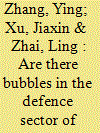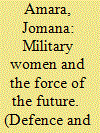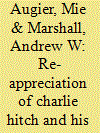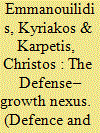|
|
|
Sort Order |
|
|
|
Items / Page
|
|
|
|
|
|
|
| Srl | Item |
| 1 |
ID:
171019


|
|
|
|
|
| Summary/Abstract |
During the past decade, China’s defence industry has experienced significant reforms, with increasing numbers of defence companies being listed on the stock market. Meanwhile, China’s stock market has suffered from dramatic fluctuations. This article, therefore, attempts to break new ground on an empirical research agenda to detect bubbles in the defence sector of China’s stock market and how these bubbles can be impacted by the entire stock market and defence industry. To explain this issue, sequential unit root tests are introduced to investigate the existence of bubbles in the defence sector using monthly frequency data from China’s stock market from January 2005 to June 2016. The empirical results show strong evidence of explosive behaviours in the defence sector during the past decade. Moreover, the number of bubbles has changed greatly when accounting for the entire stock market. The empirical results indicate that bubbles in the middle of 2006 and at the end of 2014 were driven by the defence industry because of the sharp increase of military expenditure and the release of innovative defence reforms. Finally, we suggest that the government could control the annual budget increase at a steady pace and implement defence reforms by carrying out experimental units gradually.
|
|
|
|
|
|
|
|
|
|
|
|
|
|
|
|
| 2 |
ID:
171015


|
|
|
|
|
| Summary/Abstract |
The success of military recruiting depends largely on the potential consequences of military services. This study examines how military service affects labor market outcomes of veterans. Specifically, I focus on how the Transition Assistance Program (TAP), a career assistance program, help military personnel transition to the civilian labor market. To identify the effects of TAP, I exploit variation in program accessibility generated by its initial rollout process. Using data from the Current Population Survey, I find that TAP improves the labor market outcomes of veterans, measured approximately ten years after separation. Specifically, it leads a significant increase in labor force participation. One possible mechanism is that TAP encourages the use of the GI Bill, a program that provides financial assistance to attend institutions of higher education.
|
|
|
|
|
|
|
|
|
|
|
|
|
|
|
|
| 3 |
ID:
171012


|
|
|
|
|
| Summary/Abstract |
While women have been present on battlefields through history, their roles have expanded considerably in recent decades. The lifting of remaining restrictions fits into the pattern of expansion over time. Here, we focus on the Marine Corps infantry. We model the entry of women into infantry positions over time, but we also provide context for the current changes based on previous U.S. experience, and the experiences of other countries. Previous experiences opening closed occupations to women suggest that a variety of specific strategies are likely to be helpful to the Marines’ integration efforts. Both our cost model and previous experiences suggest that the proportion of women in the Marine Corps infantry is likely to grow very slowly; rates at which women complete training and remain in the Marine Corps will have a substantial impact on this growth. Mostly because growth is expected to be slow, the personnel-related costs of integration are predicted to be modest.
|
|
|
|
|
|
|
|
|
|
|
|
|
|
|
|
| 4 |
ID:
171011


|
|
|
|
|
| Summary/Abstract |
omen are one of the fastest growing segments of the U.S .military population. Since the U.S. Department of Defense rescinded ‘Direct Ground Combat Definition and Assignment Rule,’ and implemented the 2016 policy to allow women into combat arms, the next time the United States goes to war, women will be at the battle forefront. This special issue of Defence and Peace Economics (DPE) explores the implication of the directive on the demand and supply of military labor and possible substitution and complementarity within military occupational classifications in response to the directive. The three papers highlighted in this special issue approach the status of women in the forces from three different aspects, integration, health, and education.
|
|
|
|
|
|
|
|
|
|
|
|
|
|
|
|
| 5 |
ID:
171013


|
|
|
|
|
| Summary/Abstract |
The objectives of this study were to compare gender differences in patient activation (i.e. engagement) among Veteran VA health care users, and determine if high engagement is associated with gender. A mailed national survey with Veterans provided demographics and the main outcome, patient engagement (e.g. Patient Activation Measure (PAM) scores). Administrative databases identified: history of military sexual trauma, illness severity (e.g. Charlson Comorbidity Index scores). Bivariate comparisons were conducted by gender, and multivariate logistic regression examined whether patient engagement was independently associated with being a woman Veteran, when controlling for confounders. Bivariate analyses revealed that women Veterans (vs. male Veterans) Veterans reported higher average levels of engagement (59.72 vs. 56.00, p = 0.0008). Multivariate analyses revealed that women Veterans were 1.5 times more likely than male Veterans to report being most highly engaged in their health/health care (e.g. activation scores classified as PAM level 4) [OR = 1.52, CI95 1.06–2.18, p = 0.0079]. Collectively, results indicate that women Veterans are more engaged in their health/health care than male Veterans are. Improvement efforts should focus on narrowing gender differences in patient engagement in health/health care among Veterans receiving care from the VA.
|
|
|
|
|
|
|
|
|
|
|
|
|
|
|
|
| 6 |
ID:
171017


|
|
|
|
|
| Summary/Abstract |
This paper discusses central ideas in the work of Charles Hitch. He is known for his pioneering contributions to defense economics and ‘systems analysis’ and for his introducing program budgeting in McNamara’s Pentagon. We discuss the evolution of his work and ideas, and how his views on systems analysis were influenced by his broader interest in human and organizational behavior. The paper also emphasizes Hitch’s skills as leader and manager of organizations (in particular as the head of the economics department at RAND).
|
|
|
|
|
|
|
|
|
|
|
|
|
|
|
|
| 7 |
ID:
171018


|
|
|
|
|
| Summary/Abstract |
A great part of the defense literature is focused on the interaction between military spending and economic activity. To investigate this interrelationship, researchers have applied a wide variety of methodologies with totally different assumptions and statistical properties. Until today, however, no detailed examination of the sensitivity of empirical results to the various statistical methods has been provided in the literature. The present paper attempts to fill this gap by providing, firstly, a review of the majority of the time series methodologies used in the defense–growth literature and, secondly, an econometric application using data of the U.S. economy over the period 1961–2015 in order to establish empirically the association between econometric procedures and empirical results. The empirical findings of the conducted analysis suggest that statistical methods can indeed become a significant source of variation in the investigation of the defense–growth nexus.
|
|
|
|
|
|
|
|
|
|
|
|
|
|
|
|
| 8 |
ID:
171014


|
|
|
|
|
| Summary/Abstract |
This paper offers a first view on the potential economic outcomes for American women serving along-side men in combat roles. Specifically, this paper examines the impact of deployment and exposure to intense combat for women who served in the most high-risk occupations open to them in Iraq and Afghanistan on their subsequent use of GI bill benefits for higher education. It also compares these women to men who served in the same capacities and women who served in lower risk occupations. Women in general, and in these occupations in particular, were more likely than their male counterparts to use the GI bill. Following deployment, this paper presents robust evidence that women in all capacities, and men, were more likely to use their GI bill benefits. Moreover, exposure to intense combat, which was far more likely to impact these women than other women, detracted from their propensity to use the GI bill. This negative impact on pursuit of higher education was similar for both men and women. Taken together, this paper provides evidence that deployment may benefit the young men and women alike who serve in the U.S. military, and that both suffer together when faced with exposure to intense fighting.
|
|
|
|
|
|
|
|
|
|
|
|
|
|
|
|
|
|
|
|
|